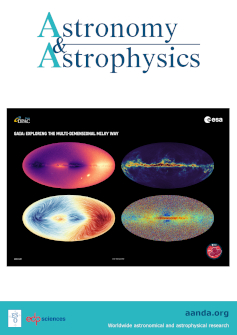Into the depths: Unveiling ELAIS-N1 with LOFAR’s deepest sub-arcsecond wide-field images
IF 5.4
2区 物理与天体物理
Q1 ASTRONOMY & ASTROPHYSICS
引用次数: 0
Abstract
We present the deepest wide-field 115–166 MHz image at sub-arcsecond resolution spanning an area of 2.5° × 2.5° centred at the ELAIS-N1 deep field. To achieve this, we improved the direction-independent (DI) and direction-dependent (DD) calibrations for the International LOw Frequency ARray (LOFAR) Telescope. This enhancement enabled us to efficiently process 32 h of data from four different 8-h observations using the high-band antennas (HBAs) of all 52 stations, covering baselines up to approximately 2000 km across Europe. The DI calibration was improved by using an accurate sky model and refining the series of calibration steps on the in-field calibrator, while the DD calibration was improved by adopting a more automated approach for selecting the DD calibrators and inspecting the self-calibration on these sources. For our brightest calibrators, we also added an additional round of self-calibration for the Dutch core and remote stations in order to refine the solutions for shorter baselines. To complement our highest resolution at 0.3″, we also made intermediate resolution wide-field images at 0.6″ and 1.2″. Our resulting wide-field images achieve a central noise level of 14 μJy beam−1 at 0.3″, doubling the depth and uncovering four times more objects than the Lockman Hole deep field image at comparable resolution but with only 8 h of data. Compared to LOFAR imaging without the international stations, we note that due to the increased collecting area and the absence of confusion noise, we reached a point-source sensitivity comparable to a 500-h ELAIS-N1 6″ image with 16 times less observing time. Importantly, we have found that the computing costs for the same amount of data are almost halved (to about 139 000 CPU h per 8 h of data) compared to previous efforts, though they remain high. Our work underscores the value and feasibility of exploiting all Dutch and international LOFAR stations to make deep wide-field images at sub-arcsecond resolution.进入深海:用LOFAR最深的亚弧秒宽视场图像揭开ELAIS-N1的神秘面纱
我们展示了以ELAIS-N1深场为中心、跨度为2.5° × 2.5°的亚弧秒分辨率最深的115-166 MHz宽场图像。为此,我们改进了国际低频雷达(LOFAR)望远镜的方向无关(DI)和方向相关(DD)定标。这一改进使我们能够利用全部52个观测站的高波段天线(HBA),有效处理来自4个不同的8小时观测的32小时数据,覆盖欧洲约2000公里的基线。通过使用精确的天空模型和改进现场校准器的一系列校准步骤,DI 校准得到了改进,而通过采用更加自动化的方法选择 DD 校准器和检查这些光源的自校准,DD 校准得到了改进。对于我们最亮的校准器,我们还为荷兰核心站和远程站增加了一轮额外的自校准,以完善较短基线的解决方案。为了补充 0.3 英寸的最高分辨率,我们还制作了 0.6 英寸和 1.2 英寸的中等分辨率宽视场图像。我们得到的宽视场图像在 0.3 英寸处的中心噪声水平为 14 μJy beam-1,比洛克曼洞深视场图像在分辨率相当但只有 8 小时数据的情况下增加了一倍深度,发现的天体也多了四倍。我们注意到,与没有国际台站的 LOFAR 成像相比,由于采集面积增大和没有混淆噪声,我们的点源灵敏度可与 500 小时的 ELAIS-N1 6″ 成像相媲美,而观测时间却减少了 16 倍。重要的是,我们发现与以前的工作相比,相同数据量的计算成本几乎降低了一半(每 8 小时数据的 CPU 运算时间约为 139 000 小时),尽管计算成本仍然很高。我们的工作强调了利用所有荷兰和国际 LOFAR 台站制作亚弧秒分辨率的深宽视场图像的价值和可行性。
本文章由计算机程序翻译,如有差异,请以英文原文为准。
求助全文
约1分钟内获得全文
求助全文
来源期刊

Astronomy & Astrophysics
地学天文-天文与天体物理
CiteScore
10.20
自引率
27.70%
发文量
2105
审稿时长
1-2 weeks
期刊介绍:
Astronomy & Astrophysics is an international Journal that publishes papers on all aspects of astronomy and astrophysics (theoretical, observational, and instrumental) independently of the techniques used to obtain the results.
文献相关原料
| 公司名称 | 产品信息 | 采购帮参考价格 |
|---|
 求助内容:
求助内容: 应助结果提醒方式:
应助结果提醒方式:


